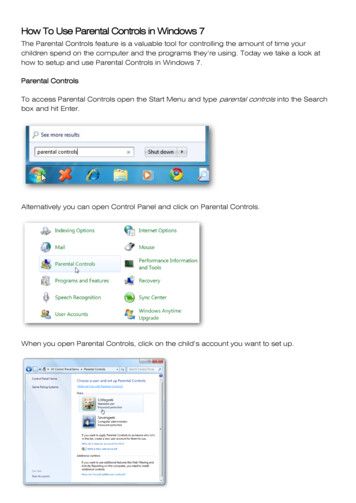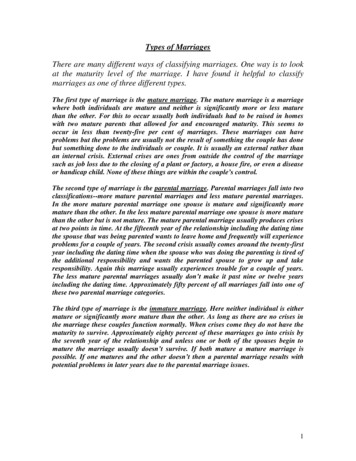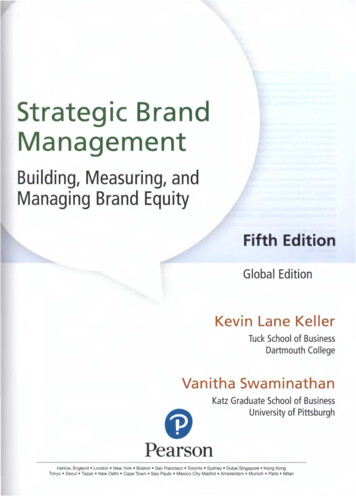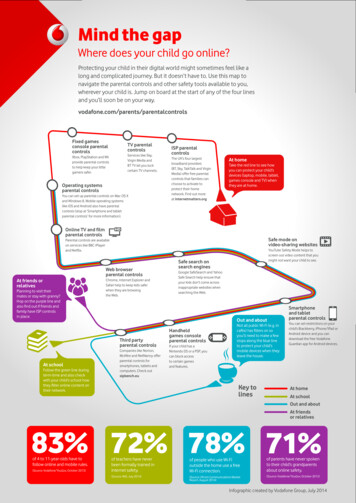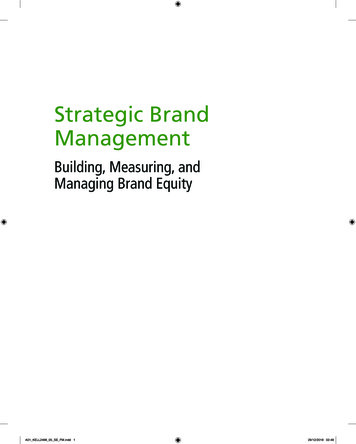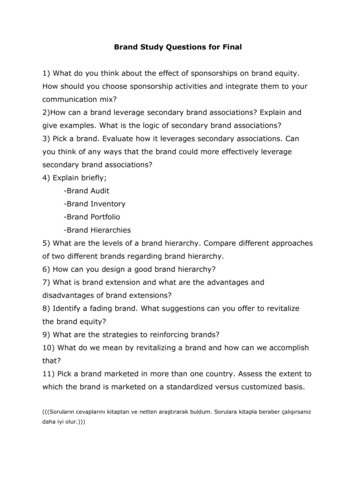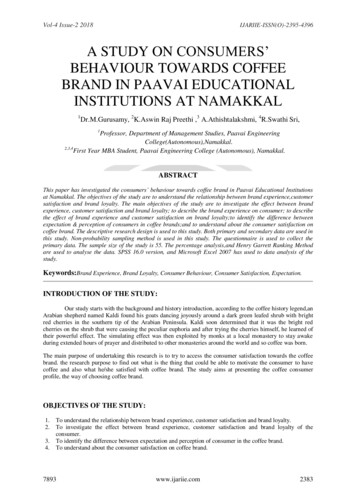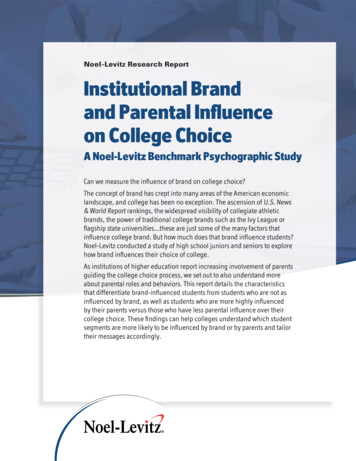
Transcription
Noel-Levitz Research ReportInstitutional Brandand Parental Influenceon College ChoiceA Noel-Levitz Benchmark Psychographic StudyCan we measure the influence of brand on college choice?The concept of brand has crept into many areas of the American economiclandscape, and college has been no exception. The ascension of U.S. News& World Report rankings, the widespread visibility of collegiate athleticbrands, the power of traditional college brands such as the Ivy League orflagship state universities.these are just some of the many factors thatinfluence college brand. But how much does that brand influence students?Noel-Levitz conducted a study of high school juniors and seniors to explorehow brand influences their choice of college.As institutions of higher education report increasing involvement of parentsguiding the college choice process, we set out to also understand moreabout parental roles and behaviors. This report details the characteristicsthat differentiate brand-influenced students from students who are not asinfluenced by brand, as well as students who are more highly influencedby their parents versus those who have less parental influence over theircollege choice. These findings can help colleges understand which studentsegments are more likely to be influenced by brand or by parents and tailortheir messages accordingly.
The value of psychographic analysis in understanding college choicePsychographicsis the study ofpersonality, values,attitudes, interests,and lifestyles.Demographic data are the foundation for understanding consumer behavior, and whilevaluable, demographic data alone certainly cannot illuminate the college decisionprocess. That process is highly personalized, and students with similar geographic,economic, ethnic, or other demographic similarities may choose completely differentinstitutions for higher education. Their decisions may be influenced by a range of factors,many of which are emotional.Because of these emotional influences, a psychographic analysis is more usefulfor understanding how students are influenced by institutional brand and parentalinvolvement. Psychographics is the study of personality, values, attitudes, interests,and lifestyles.1 This approach looks at the activities, interests, and opinions of people toanalyze how they spend their time and resources, uncover what they find important, andassess their impression of the world around them.2 In other words, psychographic analysiscaptures how people live their lives and what they believe—factors which are very relevantto the college choice process.About the surveyFor this study, 509 high school juniors and seniors who planned to go tocollege completed an online survey. The demographics of the respondentsample mirrored those of high school graduates who directly enrolled atcollege based on data from the National Center for Education Statistics (NCES).The survey covered a number of areas designed to capture their psychographicdata, including: Family and friend relationships Leisure activities Cell phone communication Athletics Values and benefits Ties to community Strong major/program1Jairo Senise, “Who Is Your Next Customer?” Strategy Business, 28 September rticle/enews092807?pg 02Roger Kerin, et al, Marketing: The Core, 3rd ed. (New York: McGraw Hill/Irwin, 2008), 110.2 2009 Noel-Levitz, Inc. 2009 Institutional Brand and Parental Influence on College Choice: A Noel-Levitz Benchmark Psychographic Study
The influence of college brand versus parental involvementThe survey confirmed that institutional brand sensitivity and parental influence have a measurable,co-occurring effect on the college choice process. Data from the respondents allowed us to createtwo scales: a Brand Scale and a Parent Scale.3The Brand Scale rates how much a student is influenced by the brand of an institution. The ParentScale shows how much a student is influenced by their parents regarding college choice. Therespondents to this study were grouped as follows:Brand/Parent Scale Grouping of Respondents13021 Students most heavily influencedby brand252 Students highly influencedby both brand and parents3 Students most heavily influencedby parents20BrandScaleScore4 Students not highly influencedby either15105340TM051015202530Parent Scale ScoreWhat did it mean for students to be ranked highly on one scale? The following sections discuss thecharacteristics of students and their parents that factor into these two scales. These characteristicsallow us to create a profile of the types of students who are more likely to be influenced by collegebrand or by the involvement of their parents.3Both of these scales showed high reliability, with Chronbach’s alpha scores of 0.724 for the Brand Scale and0.765 for the Parent Scale. 2009 Noel-Levitz, Inc. www.noellevitz.com 3
Characteristics of students who are more influenced by college brandStudents who were higher on the Brand Scaletended to share a number of characteristics.First, they had three fundamental beliefs aboutthe benefits of a college’s brand.Students higher on the Brand Scale believe Employers are more likely to hire studentsfrom certain institutions than others. Graduates from those schools will make moremoney than graduates from other institutions. A degree from one school is not equivalentto a degree from another, even when thosedegrees carry the same accreditation.While these results are not that surprising—students more inclined to be influenced bycollegiate brand would be the very sort lookingfor distinct differences between institutionalbrands—they start to form a profile of thekinds of students who are more susceptibleto institutional brand. A number of othercharacteristics emerged as well.Students higher on the Brand ScaleFurthermore, students who were moresusceptible to brand influence had additionalcharacteristics in common.Additional characteristics ofbrand-influenced students Their parents completed higher levels ofeducation, but their siblings did not attendcollege. They have higher levels of family income. Female students appear more influenced bybrand than males. Asian students scored higher on the BrandScale than African American or Hispanicstudents.Among the survey items, there were a numberof questions that would have been expected toaffect brand influence, but when analyzed, theyhad no significant bearing on a student’s brandreceptivity.Notable characteristics that did not affectbrand influence Show a greater desire for independence byplanning to not continue dating the personthey dated in high school, keep their currentjob, or live at home. Friends were going to the student’s firstchoice campus. Plan to work somewhere other than theirhome town after graduating. The student’s family followed a favoritecollege team. Perceive that their first choice for college isthe best in technology, program of study,teaching, research, social life, location,sports, and/or value. The student planned to live in a dorm. Parents were saving for college. The student planned to get involved in clubsand support a college’s athletic teams. Wear apparel with a collegiate logo orbranding. Have higher grade averages and take honorsor AP courses. Plan to enter doctoral programs aftercompleting their undergraduate educations.4 2009 Noel-Levitz, Inc. 2009 Institutional Brand and Parental Influence on College Choice: A Noel-Levitz Benchmark Psychographic Study
Characteristics of students heavily influenced by their parentsParental involvement can certainly play a largerole in the college decisions of prospectivestudents—especially in an era of growing“helicopter parents” who are very hands onwith their children’s educational careers.What types of parental characteristics signaledhigh levels of parental involvement?Parental characteristics that increase astudent’s Parent Scale ranking Chose high school classes for the studentand/or rearranged classes so the studentcould have a different teacher. Volunteered at the school or were roomparents. Applied pressure toward choosing a specificcollege. Talked about grades with students. Had a savings account for college. Assisted with SAT/ACT tests, such as signingup students for the test, enrolling thestudent in a prep course, or purchasing testpreparation materials. Helped to obtain and complete applicationsand financial aid forms. Read letters, brochures, and viewbooks fromthe college.Cell phone usage also has allowed parents toincrease their level of communication with theirchildren. Accordingly, students with more e-savvyparents tended to be more influenced by them.Parental e-communications characteristics thatlead to higher Parent Scale rankings Communicate with their children by text. Have become friends with their children onFacebook. Make phone calls to their children throughoutthe day.Family activity levels played a significant role aswell. Students who were more involved with theirfamilies tended to be more influenced by themwhen it came to choosing a college.Family activities that increase a student’s ParentScale ranking The student’s family eats dinner together. The student’s friends hang out at the family’shome. Parents encourage the student to join clubs,band, or play sports. The family attends sports events together or hasa favorite college team. Visited the Web site of a college to gatherinformation for their children, or made directphone or e-mail contact with a campus forthat information.Finally, several other characteristics indicated anincrease in parental involvement and thereforeled to a higher ranking on the Parent Scale forstudents. Reviewed college ranking guides.Additional parental involvement characteristicsthat increase the Parent Scale ranking Visited the campus. Are legacy parents who want their children tocarry on the family tradition of attending theschool they attended. Have been active in alumni clubs or attendcampus-related events.The increasing level of parental involvementhas been fueled in part by a surge in parentaluse of e-communications tools such as theWeb, text messaging, and social networking. Parental involvement rises with householdincome. Parents of white students tended to be moreinvolved than parents of Hispanic students. Parents of seniors were more involved in thecollege process than juniors. Male students reported greater parentalinvolvement than female students. Parents who wished for their children toattend a religious-affiliated school were moreinvolved. 2009 Noel-Levitz, Inc. www.noellevitz.com 5The increasing levelof parentalinvolvement has beenfueled in part by asurge in parental useof e-communicationstools such as the Web,text messaging, andsocial networking.Students with moree-savvy parents tendedto be more influencedby them.
Conclusions: Five ways campuses can apply these findings1) Assess prospective students for brand influence, parental influence, or bothHow can you assessand qualify yourcurrent prospectsfor brand or parentalinfluence?While the characteristicspresented in thisstudy identify generalcharacteristics of brandand parental-influencedstudents, everyprospect pool is unique.Conducting additionalresearch into yourprospects can help youidentify characteristicsthat will focus yourcommunications morestrategically, leading tomore tailored messagesthat will have a greaterimpact on enrollment.To learn more abouthow you can do this,contact Noel-Levitztoday. Call 1-800-876-1117and ask to speak witha Market Researchconsultant, or e-mailContactUs@noellevitz.com.Is a prospective student highly influenced by your brand? Will his or her parents play a role in choosinga college? Making these qualifications can help you understand not just what communications will push aprospective student to enroll, but also whether you should be targeting the student’s parents with thosecommunications.For instance, if you learned that a prospective female Asian honors student was interested in doctoralstudy, she would probably be more receptive to messages emphasizing the institution’s brand. A whitemale student who is Facebook friends with his mother, and whose mother was very active at his highschool, is likely to be heavily influenced by his parents.2) Provide specific outcomes data to brand-influenced studentsNearly all prospective students look for program quality and outcomes information, but if students havecharacteristics that place them higher on the Brand Scale, those students will want to see specific, crediblestatistics and examples of the benefits your campus offers over others. Communicate job placement andearning potential of graduates when possible, along with benefits in programs of study, teaching, research,and technology. Brand influenced students will look for third-party endorsements, rankings, and awards.Students interested in graduate study will want to know what your campus offers or how well graduatesfrom your campus place into highly regarded graduate or professional programs.Benefits beyond the economic can be very persuasive with brand-oriented students as well. Location,athletic offerings, and campus life can sway brand-oriented students. If a student seems more influencedby brand, try to learn their interests in these areas and communicate your distinctive benefits along withthe outcomes of an education from your campus.3) Employ different strategies according to the level of parental influenceWhen a prospective student has highly involved parents, you will need to engage his or her parents as wellas the student as “co-purchasers.” Winning over the parents of these students can have a significant impacton the student’s decision. Consider strategies such as providing a Facebook parent site where prospectiveparents can connect with each other and current student parents, including messages about campus lifeopportunities, and providing parallel programs for parents during campus visits and orientation. Surveyingparents of your prospective students about what they expect for their children’s college experiences canalso uncover valuable information for engaging both prospective students and their parents.For students with less parental involvement, it will be important to begin student outreach earlier. Workwith counselors and teachers to offer programs and workshops to assist students in preparing for collegeand navigating the college selection and financial aid processes. If students are of the first generation toattend college, you may offer summer bridge programs, peer advising, and faculty mentors.4) Cultivate your pool of legacy prospectsAccording to the research, legacy parents tend to exert considerable influence over the college choice oftheir children. Find out if your alumni have children of college age and build a communication stream withthem. Creating admissions advocates out of your alumni can be a very simple, cost-effective way to recruittheir children.5) Start building your influence early in high schoolThis survey included juniors and senior, and among brand-influenced students, there were no significantdifferences in their responses. With students who were higher on the Parent Scale, seniors did have moreconversations per month about college with their parents (10 per month), but juniors still had six collegeconversations per month with their parents.Regardless of the type of student, beginning your communication flow early—with students and parents—is a sound strategy.6 2009 Noel-Levitz, Inc. 2009 Institutional Brand and Parental Influence on College Choice: A Noel-Levitz Benchmark Psychographic Study
Additional findings: differences by ethnicity and family incomeEthnic differences in the scale rankingsWhen examining the data by ethnicity, brand had a greater influence on Asian students than onother ethnic groups, followed by white students. Hispanic and black students were less likely to beinfluenced by brand.Brand Scale by Race/EthnicityAverageBrandScaleScoreTMRace/Ethnic GroupWith regard to parental influence, white and black students scored slightly higher on the parentalscale, but the results were closer between the different ethnic groups than the brand scale.Parent Scale by Race/EthnicityAverageParentScaleScoreTMRace/Ethnic Group 2009 Noel-Levitz, Inc. www.noellevitz.com 7
Income differences in the rankingsLooking at the data by family income level, brand influence rose somewhat with income, but did notreally leap out until reaching the highest family income level.Brand Scale by Income RangeAverageBrandScaleScoreTMIncome RangeParental influence was fairly high across all income levels, showing the strongest influence onstudents from households making 50,000- 150,000 per year.Parent Scale by Income RangeAverageParentScaleScoreTMIncome RangeNote that students can show equal influence on the brand and parent scales. In the case of studentsfrom the 50,000- 100,000 family income levels, they showed close scores on both scales. Thismeans campuses would be advised to promote their brand to students from this income level whilealso attempting to win the support of their parents as well.8 2009 Noel-Levitz, Inc. 2009 Institutional Brand and Parental Influence on College Choice: A Noel-Levitz Benchmark Psychographic Study
Differences in parent scale by first-generation statusThere was also a difference in scores on the Parent Scale between first-generation students andnon-first-generation students:Parent Scale by First Generation StatusAverageParentScaleScoreTMThese results show that children of parents who matriculated to college are more likely to beinfluenced by them than students who are the first in their families to attend college. 2009 Noel-Levitz, Inc. www.noellevitz.com 9
IowaColoradoContact us at:2350 Oakdale BoulevardCoralville, Iowa 52241-9702Phone:800-876-1117319-626-8380Questions about this study?Please contact us if you have any questions about Institutional Brand andParental Influence on College Choice. Call Kathryn Karford of Noel-Levitz at1-800-876-1117 or e-mail ellevitz.comWeb:www.noellevitz.comAll material in this paper iscopyright by Noel-Levitz, Inc.Permission is required, inmost cases, to redistributeinformation from Noel-Levitz, Inc.,either in print or electronically.Please contact us at ContactUs@noellevitz.com about reusingmaterial from this paper.About Noel-LevitzNoel-Levitz is a nationally recognized consulting firm that specializes in strategic planning forenrollment and student success in higher education. Each year, higher education executives fromthroughout the U.S. meet regularly with Noel-Levitz to accomplish their goals for student recruitment,marketing, student retention, and strategic enrollment management.Since 1973, Noel-Levitz has partnered with nearly 2,000 colleges and universities throughoutNorth America. The firm offers consulting, custom research, benchmark data, innovative toolsand technologies, side-by-side plan development and execution, and resources for professionaldevelopment. For more information, visit www.noellevitz.com.Find it online.This report is posted online at www.noellevitz.com.Sign up to receive additional reports and updates.Visit our Web page: www.noellevitz.com/subscribe10 2009 Noel-Levitz, Inc. 2009 Institutional Brand and Parental Influence on College Choice: A Noel-Levitz Benchmark Psychographic StudyP0301009
has been fueled in part by a surge in parental use of e-communications tools such as the Web, text messaging, and social networking. Cell phone usage also has allowed parents to increase their level of communication with their children. Accordingly, students with more e-savvy parents tended to be more infl uenced by them.
